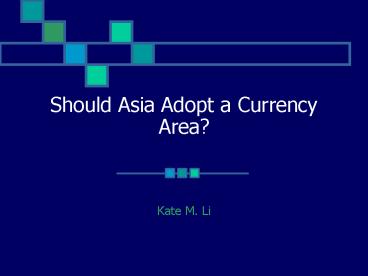Should Asia Adopt a Currency Area - PowerPoint PPT Presentation
1 / 26
Title:
Should Asia Adopt a Currency Area
Description:
VAR from Eichengreen and Bayoumi (1994) Exchange Rate Variability. OCA Index ... Yuen's 2000 VAR study. Sample of 10 East Asian countries for 1967-1997 ... – PowerPoint PPT presentation
Number of Views:51
Avg rating:3.0/5.0
Title: Should Asia Adopt a Currency Area
1
Should Asia Adopt a Currency Area?
- Kate M. Li
2
Motivation
- Interest in the Asian region
- Financial Crisis 1997
3
Benefits from a Currency Area in Asia
- Increase in Trade
- Reduction in Exchange Rate Uncertainty
- Greater Market Transparency
- Spur New Growth
4
Support
- Frankel and Rose (2001)
- Data set of economic and geographic variables for
over 200 countries - Results
- Common currencies promote bilateral trade
- By raising overall trade, Currency Union also
raises income
5
Support
- Ricardo Hausmann has stressed that currency union
would help developing countries by increasing
access to attractive forms of long term financing - Barro (2001) argues that for most countries a
C.A. provides a much better commitment device
than alternative forms of fixed exchange rate
6
OCA criteria
- Similarity in structure and shocks
- Openness of economies
- International factor mobility (Mundell 1961-labor
mobility) - Product Diversification (Kennen 1969)
- Fiscal Transfers (Kenen 1969)
- Degree of policy integration and similarity
between rates of inflation (Dixit 2000)
7
Methodology
- Qualitative approach
- OCA Index from Eichengreen and Bayoumi (1996)Is
Asia an Optimum Currency Area? Can it become
one? Regional, Global and Historical
Perspectives on Asian Monetary Relations - VAR from Eichengreen and Bayoumi (1994)
8
Exchange Rate Variability
9
OCA Index
- OCA Index is the predicted level of exchange rate
variability - Sample Japan and its 19 leading trading partners
over the period 1976-1995 - Equation
- SD (eij ) a ß1 SD (?yi- yj ) ß2 DISSIM ij
ß3 TRADEij ß4 SIZEij
10
Results
11
Symmetry of Shocks
12
VAR
- Use the structural VAR methodology of Blanchard
and Quah (1989) to provide a detailed analysis of
asymmetric disturbances - Sample 1972-1989
13
Results
- The demand shocks of Hong Kong, Indonesia,
Malaysia, Singapore, and Thailand are relatively
highly correlated with one another - The supply shocks side, 2 groups of Asian
countries are significantly correlated - Japan, Korea and Taiwan
- Hong Kong, Indonesia, Malaysia, and Singapore
14
Yuens 2000 VAR study
- Sample of 10 East Asian countries for 1967-1997
- Suggests 3 set of groupings
- Singapore and Malaysia
- Japan and Korea
- Taiwan and Hong Kong
15
Degree of Openness
16
Trade Integration
- Bilateral Trade Table (Wyplosz)
- Major Trade Trends in East Asia-Francis Ng and
Alexander Yeats (2003)
17
International Factor Mobility
18
Labor Mobility
- Eichengreen and Bayoumi (1996) Labor mobility in
Asia, relatively high. - Example, in Singapore, workers from Malaysia,
Thailand, Indonesia and Philippines accounted for
fully 10 of employment in the 1980s. - The elasticity of supply of Chinese workers to HK
is notoriously high.
19
Argument
- Asia should be first divided into small
clusters and then integrate into a larger
currency area
20
Obstacles
21
Obstacles
- Different economic, cultural and financial
structures - Differences in the level of development
- Lack of political aspirations
22
Criticism of OCA theory
- Endogeneity of certain OCA criteria some
countries might not satisfy the criteria of
joining monetary union, but can achieve them
later in the future, hence, ex poste rather than
ex ante.
23
Is a Currency Area in Asia Possible?
24
Eichengreen and Bayoumi (1996)
- East Asia lacks the political solidarity and
cohesion to institutionalize a durable system of
collective currency pegs. - It is hard to believe that Beijing would permit
other East Asian countries to mandate a change in
Chinese macroeconomic policy as a quid pro quo
for intervention in support of the renminbi, or
that other countries would entrust Beijing with
this authority in return for its support
25
Mundell Does Asia need a common currency? 2002
- According to him, the answer depends on what the
alternative to it is. - If the alternative is the present system, then
my answer is yes, Asia needs a common currency.
If however, the alternative to it is a global
currency, which I think would be the best
solution, then my answer is Asia does not need a
separate common currency.
26
Brunei Singapore































